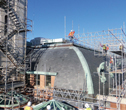For some time, NRCA has been investigating moisture in lightweight structural concrete roof decks and made recommendations in August to its membership regarding the use of such products. If you are involved in the design or installation of roof systems on concrete roof decks, you should be aware of these moisture-related concerns.
Previous research
Since 2009, NRCA has received a significant number of reports of moisture-related problems associated with lightweight structural concrete roof decks. Problems include moisture accumulation, loss of adhesion of roofing layers, adhesive issues with water-based and low-volatile organic compound adhesives, metal and fastener corrosion, and insulation R-value loss.
Rene Dupuis, president of Structural Research Inc., Middleton, Wis., and I presented a paper at the 2011 International Roofing Symposium that discussed the high moisture content and humidity present in lightweight structural concrete roof decks four to seven years after placement. Roof system performance issues related to the roof decks' moisture was noted in each of the projects studied.
In "Concrete deck dryness," January 2012 issue, page 12, I noted the historical methods of determining relative dryness of concrete roof decks no longer are adequate when evaluating current concrete mix designs and lightweight structural concrete roof decks. Use of ASTM F2170, "Standard Test Method for Determining Relative Humidity in Concrete Floor Slabs Using in situ Probes," now is recommended for this purpose.
NRCA's recommendations
NRCA considers the decision of when it is appropriate to cover newly placed concrete substrates with roofing materials to be beyond roofing contractors' control. Because of the numerous variables associated with concrete mix design, placement, curing and drying, roofing contractors are not privy to and may not be knowledgeable of the information necessary to make such a decision.
A roofing contractor only can visually assess the dryness of concrete's uppermost surface; he or she cannot readily assess any remaining free moisture within concrete decks and its likely release.
NRCA recommends the decision of when to cover a newly placed concrete substrate with a new roof system be made by the building's structural engineer, general contractor, concrete supplier and concrete placement contractor, each of whom will have more knowledge than the roofing contractor about the particular concrete's curing and moisture release rates. It also may be useful to consult the building's project manager, roof system designer and roofing materials manufacturer.
NRCA's premise and position is consistent with the flooring industry. For resilient tile and textile floor coverings and coatings, floor covering manufacturers generally require quantitative moisture testing be performed before floor covering installation on concrete. ASTM F2170 testing often is used for this purpose.
Furthermore, in new construction, NRCA recommends designers not specify—and construction managers and general contractors not use—lightweight structural concrete for roof decks or as toppings for roof decks. In NRCA's opinion, the risks of moisture-related problems associated with lightweight structural concrete roof decks outweigh the possible benefits.
In the event lightweight structural concrete is used, NRCA recommends designers clearly specify concrete's drying parameters. ASTM F2170 can be used for this purpose. Until recognized pass-fail criteria applicable for determining concrete's internal humidity is developed, NRCA suggests a maximum 75 percent relative humidity value be used; lower values may be necessary when using organic-based materials, such as wood fiberboard, perlite board and some insulation facer sheets, as roof system components.
For reroofing situations where the existing roof deck is known to be lightweight structural concrete or where there is evidence of concrete deck-related moisture problems, NRCA recommends two alternative roof system designs be considered.
One option: An above-deck venting design, such as a venting base sheet, using a loosely laid ballasted roof system with perimeter venting may allow release of the concrete deck's moisture without adversely affecting roof system components. Another option: Seal the concrete's moisture into the deck by using a high-bond strength vapor retarder adhered directly to the deck followed by an adhered roof system. A high-quality, 12- to 15-mil-thick two-part epoxy has been used successfully as a vapor retarder in the flooring industry.
Mark S. Graham is NRCA's associate executive director of technical services.
Did you know?
NRCA issued an Industry Issue Update in August about moisture in lightweight structural concrete decks.
Members can view the update in the Members Only section of www.nrca.net.



